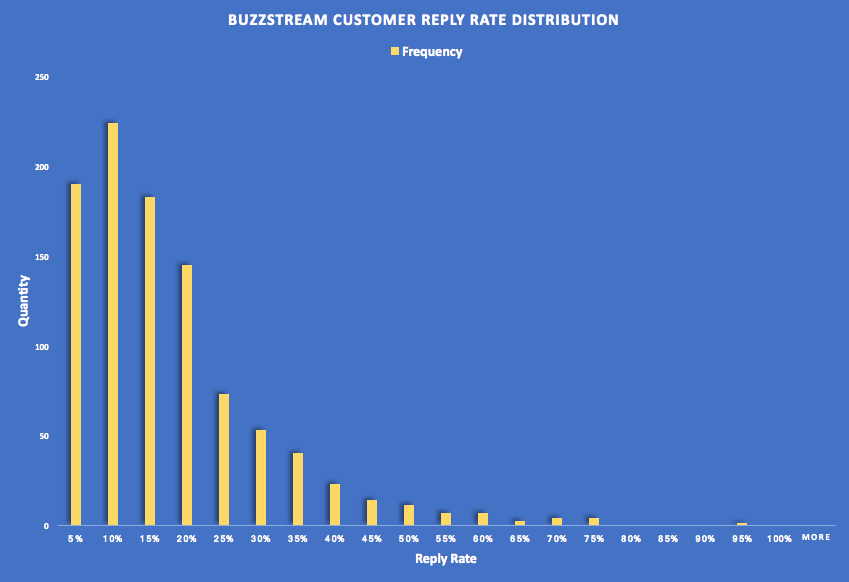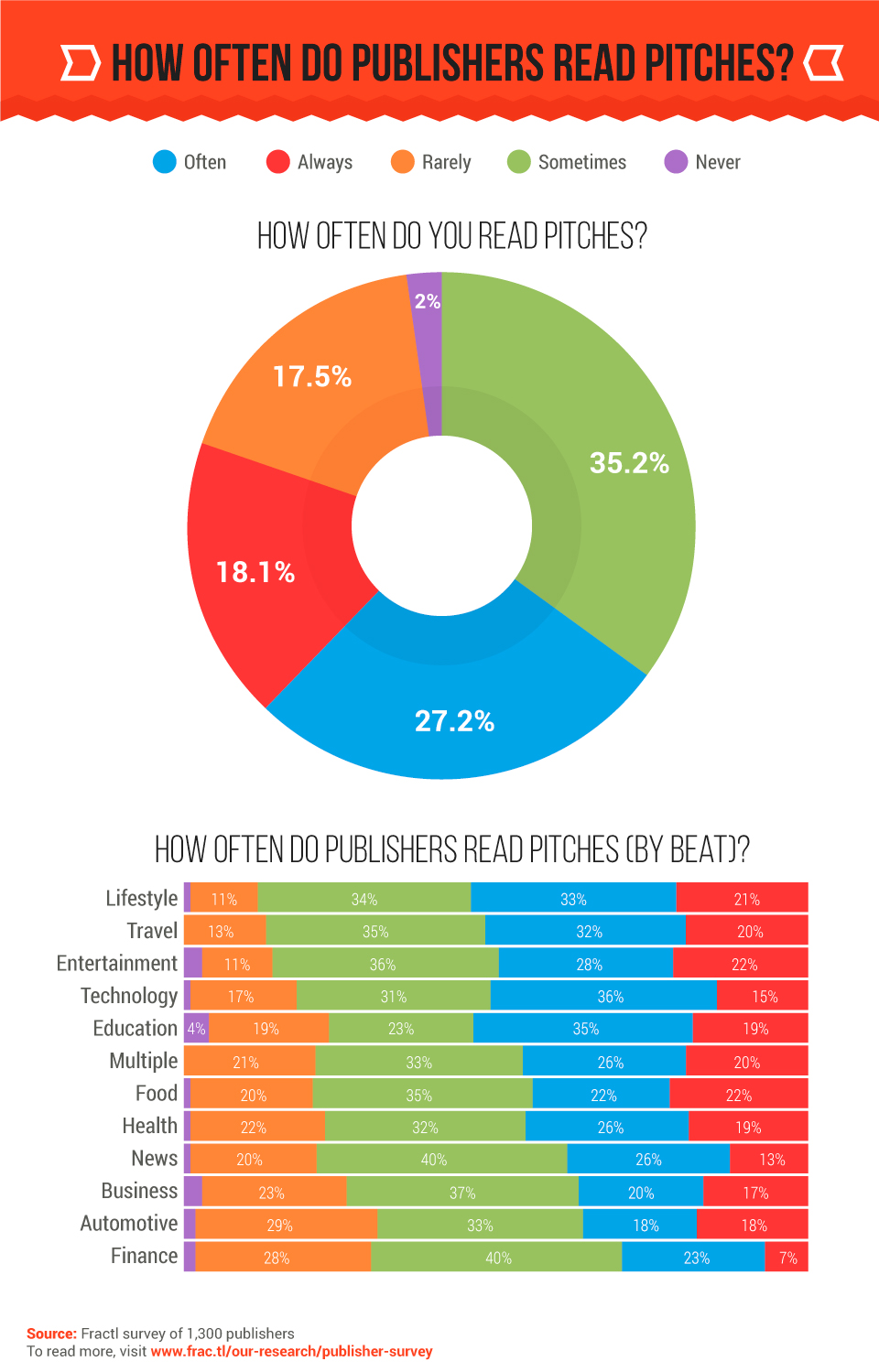In a survey of 500 top-tier publishers, Fractl discovered that 81% of editors prefer email pitches over other channels like social media, contact forms, and phone calls. We also found that 85% of editors open pitches based on your subject line. With subject lines being the ultimate gatekeeper for your open rates, Fractl and BuzzStream decided to collaborate on a new publisher survey to discover how they would improve your subject lines.
1. Lifestyle, Entertainment and Technology writers take the brunt of your pitches
In our study, we found Lifestyle, Entertainment and Technology writers account for 60% of the verticals getting pitched over 300x/day. Knowing that these verticals suffer the most news release fatigue, you should trim down your pitches to the preferred 100-200 word count. In comparison, there is significantly less competition in verticals such as Jobs, Animals, and Climate, each of which receive an average of 10 pitches/day.
2. Editors receive 68% of your pitches
PR professionals often debate about whether you should pitch editors, staff writers, or contributors; however, our research tells us that editors receive 68% of your pitches. If you want to stand out where there is less noise, try pitching staff writers with a highly targeted pitch based on that individual’s beat and previous coverage.
3. 75% of publishers prefer subject lines under 10 words
Keep your subject line as short and to the point as possible. 55% of respondents indicated that they prefer subject lines to be 6-10 words long, and the next highest requested length was 0-5 words. Anything longer and you’ll lose the attention of most editors, or you’ll risk getting your subject line cut off in an inbox.
4. 99% of publishers are against “clickbait” subject lines
More than 50% of respondents said your subject lines should be specific, descriptive, and tailored to their beat. Less than 20% want catchy, personalized, or humorous subject lines. Only 1% said subject lines should look like clickbait.
5. 70% of publishers don’t want to see CAPS, emojis, or exclamation points
Save your friendly and enthusiastic messages for when you text your friends. Publishers want you to keep your pitches professional, and avoid the phony friendliness.
6. 66% of publishers want you to indicate a standing relationship in your subject line
If you have worked with a particular writer in the past, it can be advantageous to mention that in the email subject line. 66% of publishers indicated they would be at least somewhat more likely to open your email if you reference your past relationship in the subject line.
7. Highlight your key findings
80% of writers said they would like to see your content title, a key statistic from your study, or a clearly defined pitch in the subject. Content with raw data or original research is highly desirable, with more than 85% saying they would like to see that information in your pitch.
8. 85% want raw data with your pitch
In the past two years we’ve noticed a significant uptick in publishers rejecting campaigns if the sources are not authoritative, recent, and verified. This is likely the reason that 85% of publishers want your raw data with your pitch, so they can quickly verify your information. By providing the publisher with your raw data, you also allow them to cover your campaign under the angle they are most interested in featuring, rather than a pre-formatted graphic.
9. Less than 15% of publishers are “very open” to syndications
Having the right syndication strategy in place can make or break your campaign’s success, especially when you consider that only 15% of publishers are “very open” to syndications. However, it’s important to note that the majority of these responses came from the highest authority publishers, while the mid-to-low-tier publishers are more open to covering a campaign even if they’re not the first to write about it.
10. 87% of publishers don’t want you to exceed 1-2 follow up pitches
There are many reasons a person could have missed or forgotten to respond to your original pitch, but there are very few reasons why someone would miss more than two emails from you. This is why one follow up is the standard best practice, and any more than two is perceived as spam.
11. 53% of publishers have blacklisted at least one person this month due to a bad pitch
The stakes are high when someone blacklists your email, because you’re ultimately putting your entire team at risk for having your company’s domain blocked from future pitches. That said, it’s imperative that you stay in touch with the latest pitching best practices and outreach training resources to make sure your team is ahead of the curve.
Want to learn more about the collaborative study by BuzzStream and Fractl? Read our white paper to discover 21 tips for pitching publishers!


 Check out the BuzzStream Podcast
Check out the BuzzStream Podcast


5 comments
Hi Kelsey,
What fantastic information. It almost certainly applies to email marketers writing to their lists as well. Well worth repeating everywhere a writer has to engage their audience.
Thank you so much for this valuable resource.
Regards,
Steven Lucas
Hi Anna, I’m glad you loved the graphic! It’s always great to have data that backs up our assumptions, and it’s even more valuable when data proves our assumptions wrong! I’ve seen several posts encouraging 3-5 follow up pitches, so it’s important to note that 85% of publishers want a max of 1-2 follow ups. Another surprising figure for me was that 85% of publishers want raw data with the pitch. When you consider that 53% of publishers have blocked at least one person due to bad pitching practices, this data becomes even more important! Glad we could help out.
Loved the graphic. It highlights many things we may all assume, but we now have figures to prove and can see where else to target.
Thanks for the takeaways. Several very useful nuggets in here.
In a world filled with BuzzFeed articles and top 10 lists, it’s so easy to fall into the trap of using these click-bait driven subject lines when pitching media. We live in a time when clicks rule everything. Some journalists and writers only get paid when they drive traffic so it’s a common thought that click bait is something these folks would want. Well this infographic definitely sheds light on the truth – Great job and thanks for sharing!